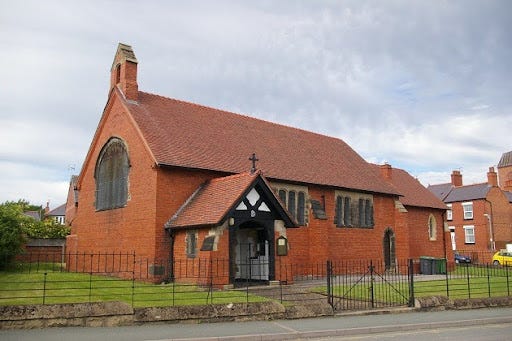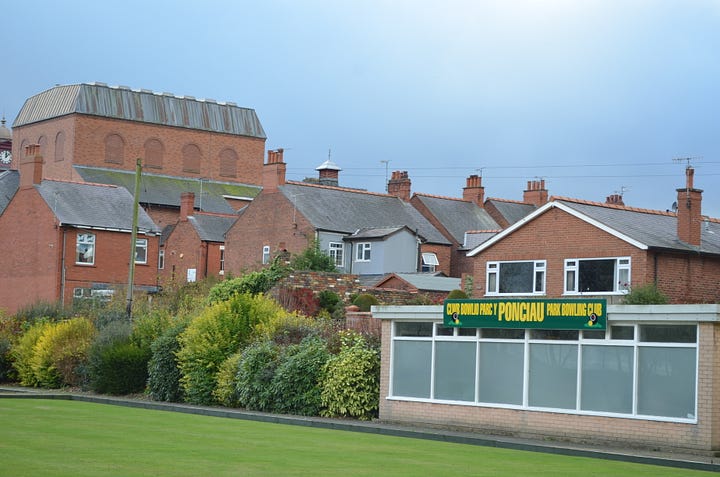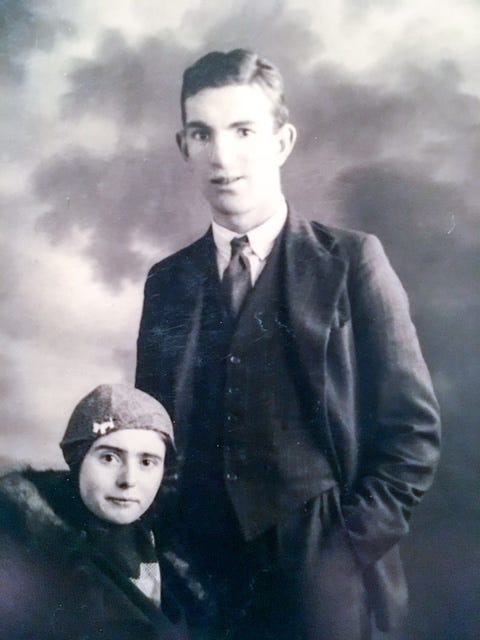Leaving Rhos: how melodies help make memories in my father's village
Sara Wheeler reflects on Welsh and Deaf linguistic and cultural experiences, and rejoices in relationships forged in Rhosllannerchrugog, Wrexham
Mae’r pyllau ‘di cau, y coets yn wag, lle mae’r Cymry o flaen y gad?
– The coalmines are shut, the Coach is empty, where are the Welsh at the forefront?
‘Gadael Rhos’, Daniel Lloyd (2009)
In ‘Gadael Rhos’ (Leaving Rhos), Daniel Lloyd laments the demise of his village, Rhosllannerchrugog, northeast Wales. Having lived through the mining strikes of the 1980s, and the subsequent pit closures and unemployment, Daniel comments on the effects these had on the community. Where once there were numerous pubs, many have closed and even the once thriving Coach and Horses is empty. Many people have moved away, and this borderlands community is left lacking in Welsh people standing their ground, particularly in terms of the Welsh language.
This is my interpretation, as someone with strong connections to the village through my father’s family. I lived through the same period and spent many of my summers in Rhos as a child, noticing the desolation and despair against the backdrop of a rich mining heritage. The whole landscape here has been heavily shaped by coal mining, and in turn the community and its culture were also shaped by this almost sole industry.
There has been a heavy emphasis on recounting the history of the coal mining communities in the south, and as a result the south Wales coalfield looms large in the public consciousness. However, a rich coal seam also runs from the northeast of Wales down to the borderlands of the southeast, and the Forest of Dean immediately on the other side; the aftermath of industrial decline in Rhos maps very closely onto that written about by Dennis Potter in The Changing Forest: Life in the Forest of Dean (1962).
Similarities between the Forest and Rhosllannerchrugog are striking, from the geography and landscape through to the culture of the communities. Geologically, both areas harbour an unusual red clay that formed the base for brick industries in both Coleford and Ruabon, and culturally both areas had traditions of bowling greens, brass bands, and male voice choirs. Religion also shaped the communities through a proliferation of chapels, which, like the numerous pubs, have seen a decline in numbers of attendees to the point of being empty and then closing altogether.




The demise of Rhosllannerchrugog was dramatic. Where once there was a thriving community, the village is now ranked third most deprived in Wrexham, according to the 2022 census. Emblematic of this decline is Y Stiwt, an impressively large former miners’ institute built with money saved by local workers, which has had mixed fortunes over the years and continues to face an uncertain future.
Opened in 1926 and built with the distinctive Ruabon red brick, this art deco building boasts multiple rooms and a two-tier theatre with a stage and large screen. My father has fond memories of Y Stiwt from his childhood in the 1950s, when it was a focal point for village life. He would visit with family members to see the latest Gilbert and Sullivan operas, play snooker, and participate in other social activities.
However, as the fortunes of the coal industry declined, so too did those of Y Stiwt, and in 1977 it closed its doors. In the 1990s there was a successful campaign to restore and reopen the building, and since 1999, a group of volunteers has struggled successfully to keep Y Stiwt open through a combination of grant applications, events, creative workshops, and a ‘Friends of Y Stiwt’ option for supporters.
Meanwhile, many in the local community feel disenfranchised and experience ennui caused by poverty, deprivation, lack of opportunities, unemployment, and the associated inequalities of health. Their ability to engage with Y Stiwt and its activities has thus also declined.
Growing up, I was fascinated by family heirlooms in the spare room, which included my great grandfather’s bowling balls in a leather bag, and my taid’s trumpet and violin. Glyn, my taid, died before I was born, but I have seen photos of him playing the trumpet and conducting the Rhos Silver Prize Band. He grew up in the village above his family’s grocery store – a situation which changed suddenly in 1926 as the General Strike brought the business to an end and everyone else from his family moved away to Llanrwst to begin again.
Music had been very important in Glyn’s family and all but one of his siblings played a different musical instrument. They had played together as a band in their Sunday School. However, his brother Trevor was deaf and, as was the way at the time, he lived at a residential school for deaf children in Manchester. Glyn had two children: my father Raymond, and Brenda, who was deaf. Brenda’s son Andrew was also deaf. Glyn’s wife, Alwen, was a coal miner’s daughter, as was her mother before her. She sang in the church choir with her two sisters Blodwen and Gwladys.


My early memories of Rhos include attending a jumble sale at Eglwys Dewi Sant, my family’s church which was opposite Y Stiwt. At school a boy from Rhos drew a detailed picture of Y Stiwt and the teacher talked gravely with him about the campaign to reopen it. I spent time singing with my nain and aunty Gwladys and learning British Sign Language (BSL) and knitting with my aunty Brenda.
Music had always been something of an enigma to Brenda. Having no hearing at all from early childhood, she was sent away at the age of three to a residential school in Liverpool, returning to Rhos at weekends, where she would attend Eglwys Dewi Sant, watching on as everyone else in the room sang hymns. Her mother would hold the hymn book between them and follow the words on the page with her finger. However, the words were in Welsh – and since Brenda lived in England throughout the week, the language was unfamiliar to her; this also meant she could not read people’s lips as they were singing.
As an adult, Brenda was fascinated by songs in the English language. She would read lyrics but could hear no sound at all. Nevertheless, she very much enjoyed going out dancing with her friends. Whilst she could feel some vibrations through the floor and other objects, she explained to me that she mostly just learnt by watching other people and copying their movements. Pondering this, I realised that this was very similar to how I had learnt to dance, my moves mostly based on the swaying and hair swishing of Abba’s Agnetha Fältskog.
Around 2011, Brenda became involved in a musical group called Wrexham’s Singing Hands, who performed popular songs interpreted into BSL. Songs were played alongside performances which included adapted signs to illustrate the elongation of notes and other musical elements. Brenda very much enjoyed being a member of the group as she was able to engage with music through activity which d/Deaf and hearing people could enjoy together.
Having been to a couple of the performances, I joined the group, and enjoyed learning BSL through practising and performing the songs. I was the only fluent Welsh speaker in the group and all the songs were English language ones. However, as the repertoire evolved, group leaders Claire and Jo decided to interpret ‘Calon Lân’ into BSL. This was a wonderful and emotional experience for Brenda, and for me. Brenda knew that her mother, Alwen, had been fond of singing this Welsh hymn, as had I.
Around this time I had also become aware that I too had begun to lose my hearing, and that I was likely on a similar hearing trajectory to that which my father had experienced over the last thirty years – one which had resulted in him becoming hard of hearing/deaf. But here, through this Deafhearing musical activity, we were translanguaging our Welsh and Deaf linguistic and cultural experiences and identities, making new connections, and rejoicing in memories and relationships.
I have always felt the presence of my ancestors when I visit Y Stiwt, and Rhos more generally; it’s almost as though you can feel the past pushing through to greet you – from every arched doorway, every art deco lamp, every red brick. But it also felt sad, as though that past and those sounds and voices were fading and would someday be gone forever, with silence in their place. In Rhos the air always felt heavy with coal dust and oppressive. Although it is in quite a rural location of natural beauty, and many of the houses and buildings are built from bright Ruabon red brick, my memory conjures a mostly grey and desolate place.
But quite recently a Welsh-language film called Y Sŵn was released in selected cinemas, and Y Stiwt was one of those. The film recounts the story of Gwynfor Evans’ hunger strike following Margaret Thatcher’s u-turn on a promise made to Wales about the establishment of a Welsh-language television channel. I was amazed to find the building full of people, in a way that I had never seen before, but which matched my father’s fondly recalled memories.
There was a buzz in the air, even before the film began – a revival of village life, mae’r Cymry o flaen y gad after all.
Dr Sara Louise Wheeler is a freelance poet, littérateur, and artist. She writes the column ‘O’r Gororau’ (‘From the borders’) for Barddas Welsh poetry magazine, where she explores topics relating to marginal experiences, including disabilities; she also writes a bi-monthly column for Golwg360.



